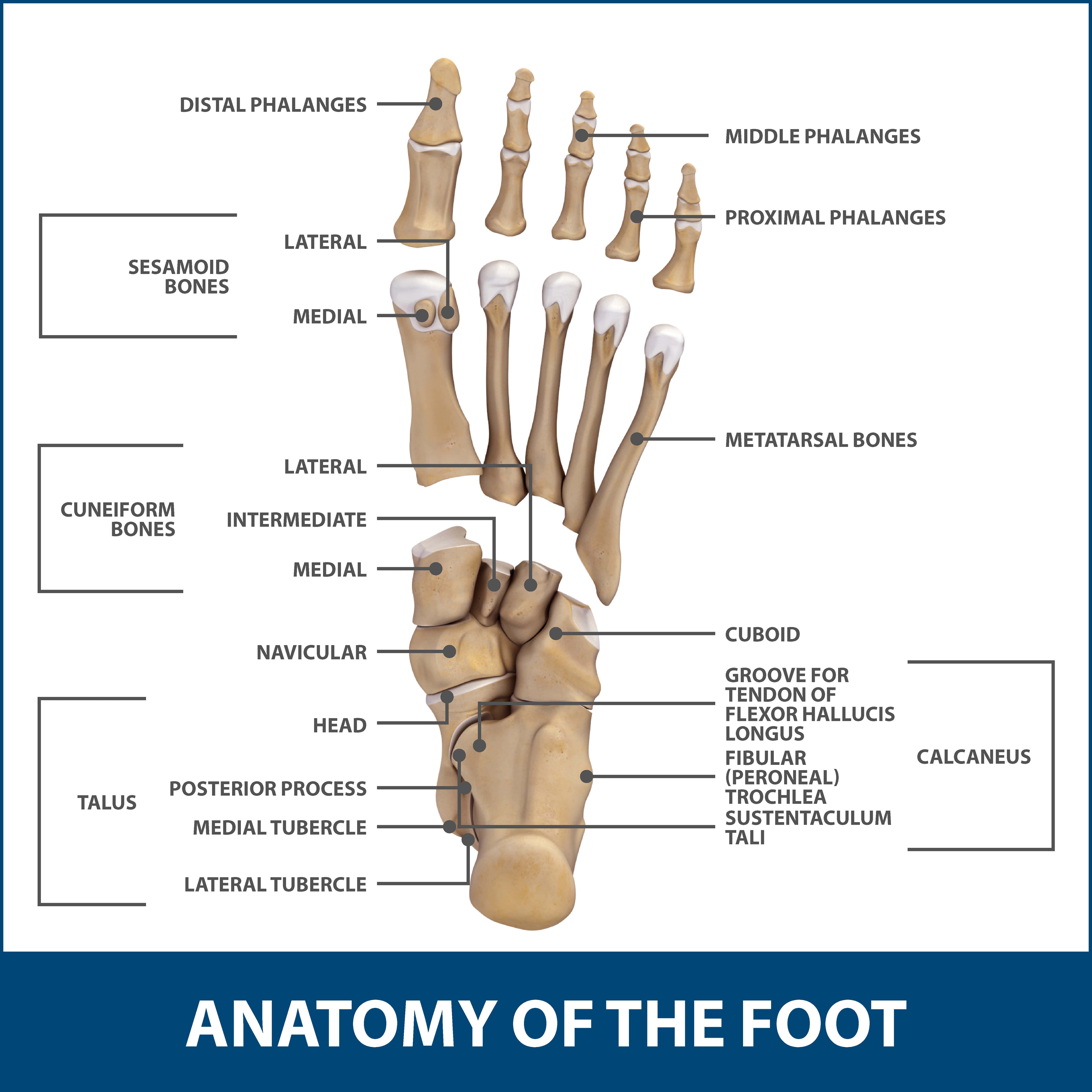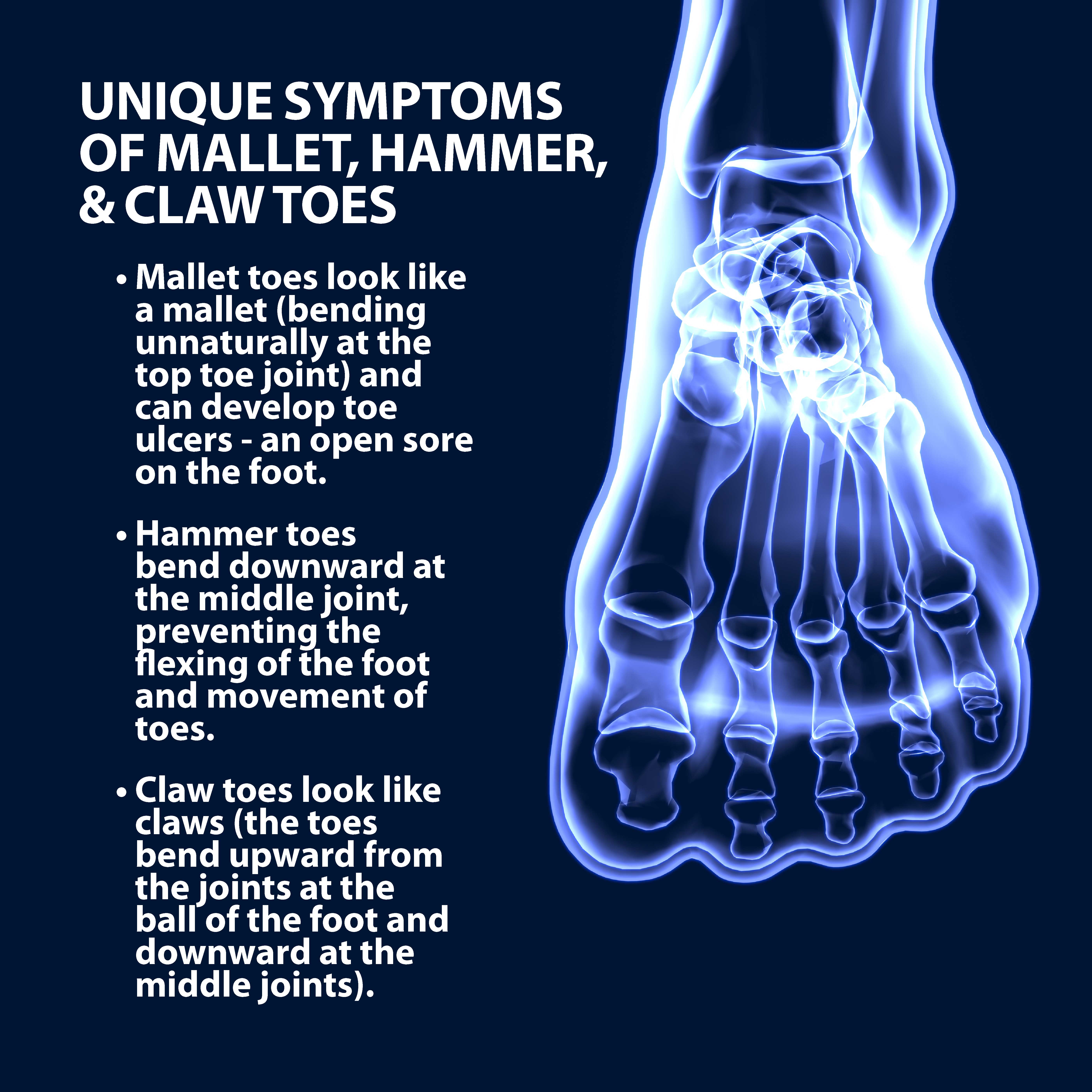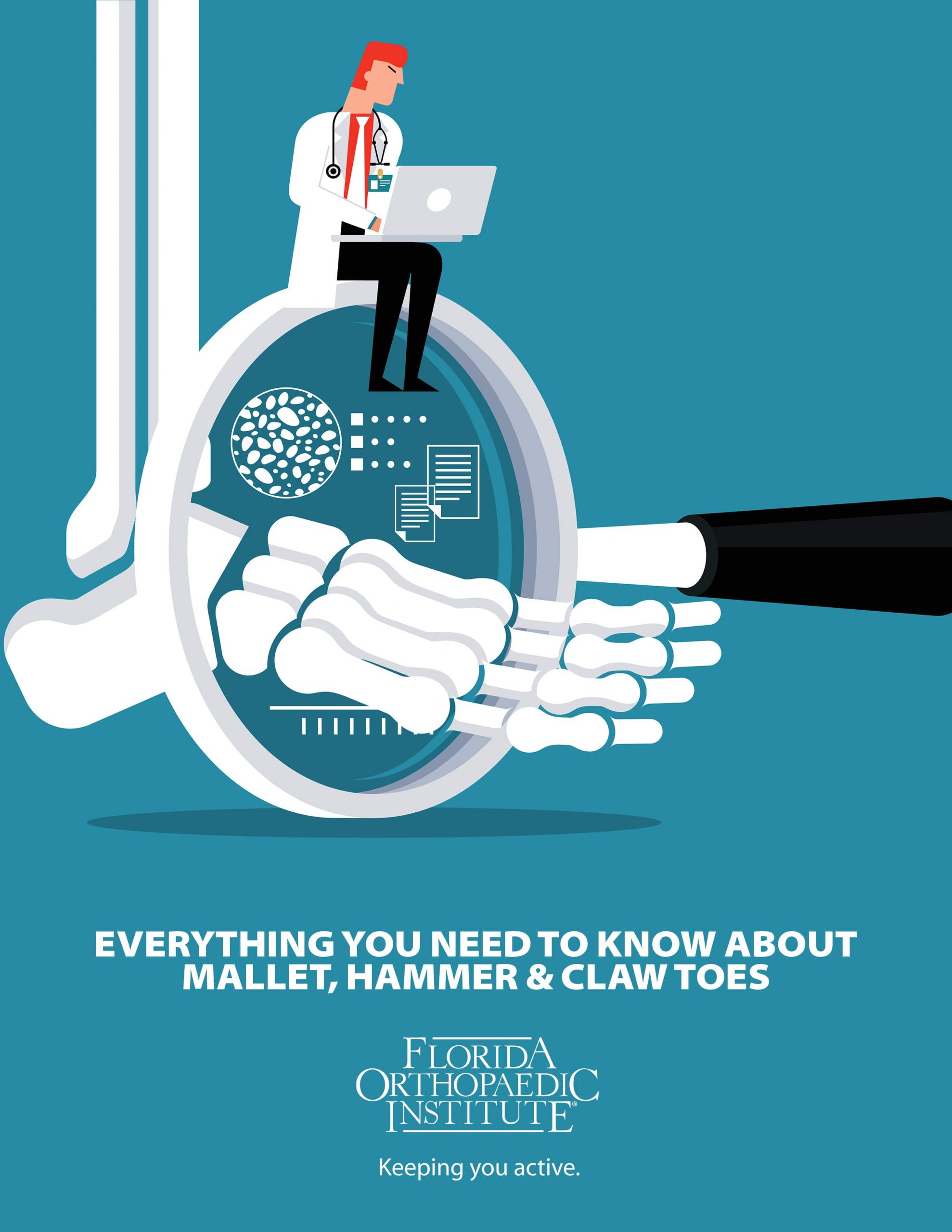Mallet, Hammer & Claw Toes
OVERVIEW
Mallet, hammer and claw toes are all toe deformities that are usually caused by improper footwear. Besides deformities, other symptoms include redness and swelling, calluses, corns, and pain. There are both surgical and nonsurgical treatment options available for these toe conditions. Normally, surgical options are not considered unless the deformity is severe or if nonsurgical treatments are unsuccessful.
ANATOMY
Aside from the big toe, each toe consists of three joints:
- Distal Phalangeal Joint (DP). Joint at the end of the toe.
- Proximal Interphalangeal Joint (PIP). Joint in the middle of toe.
- Metatarsophalangeal Joint (MCP). Joint at the base of the toe.

DESCRIPTION
Mallet, hammer and claw toes are all toe deformities that are often caused by wearing shoes that do not fit properly. When shoes do not fit, the toe muscles are forced to remain in a fixed position. Over time, these muscles will lose their ability to stretch out, resulting in these toe deformities. Toe deformities are also caused by trauma, bone and muscle imbalances, and arthritis. In mallet toe, the DP joint buckles and the skin near the tip of the toenail develops a corn that can eventually result in an ulcer.
Mallet toe can happen to any toe, but since the second toe is typically the longest, it is most likely to be affected.
A hammer toe occurs when the second, third, or fourth toes bend at the PIP joint. Hammer toe is often accompanied by corns or calluses on the top of the PIP joint or on the tip of the toe. If not treated, the toes lose their flexibility over time and become fixed.
Claw toe is a bit different from the other deformities as it can also be the result of nerve damage caused by diseases such as diabetes or alcoholism, which can potentially weaken the foot muscles. In claw toes, the toes bend and dig into the soles of the shoe, resulting in calluses.
SYMPTOMS
Mallet, hammer, and claw toes can all be characterized by redness and swelling, corns, calluses, difficulty walking, and pain. But they each have their own unique symptoms that set them apart from one another.
- Mallet toes look like a mallet (they will bend unnaturally at the top toe joint) and can develop toe ulcers – an open sore on the foot.
- Hammer toes bend downward at the middle joint and prevent the flexing of the foot and movement of toes.
- Claw toes look like claws (the toes bend upward from the joints at the ball of the foot and downward at the middle joints).

DIAGNOSIS
Your Florida Orthopaedic Institute physician will analyze your symptoms and your overall health to determine your diagnosis. Specific tests may also be required to confirm that there are no neurological disorders that can weaken the foot muscles.
TREATMENT (OVERVIEW)
There are both surgical and nonsurgical treatments available for mallet, hammer, and claw toes. Surgical procedures are only considered when nonsurgical treatments are exhausted, and symptoms have not improved.
NONSURGICAL TREATMENTS
Nonsurgical treatments for mild to moderate cases of mallet, hammer, and claw toes are all treated similarly. The treatment starts off with new shoes that have soft, roomy toe boxes. Some exercises may also be recommended to help stretch and strengthen the toe muscles. Your physician may also recommend products to help reduce corns and calluses, as well as non-steroidal anti-inflammatory medication such as Advil and Motrin (ibuprofen) or Aleve (naproxen) to help reduce pain and swelling.
SURGICAL PROCEDURES/TREATMENTS
Surgical treatment is only recommended if the mallet, hammer, and claw toes are severe, or if nonsurgical treatments were unsuccessful. Claw and hammer toes can both be treated with arthroplasty – the surgical reconstruction or replacement of a joint. In hammer toes, the arthroplasty is done in the DP joint by removing one side of the joint, releasing the tension on the tendons and ligaments around the joint. The toe can then be realigned into its proper position. A metal pin or stitches are used to help keep the toe in the correct position during the healing process.
The procedure for claw toes is the same except the arthroplasty is done in the PIP joint, but depending on the severity of the claw toe, the tendons and ligaments in the MCP joint may also need to be released.
For mallet toes, several procedures can be used depending on severity. If the deformity is extreme, DP joint fusion can be performed which consists of removing some of the bone in the DP joint with the rest of the joint fused together.
NEXT STEPS
Recovery time depends on the severity of the toe deformity. Your Florida Orthopaedic Institute physician will determine your specific recovery time and plan. To prevent these deformities from reoccurring, wear footwear that fits properly and does not cause the toes to bend unnaturally.
DOWNLOAD OUR FREE PDF.
Download our free pdf: “EVERYTHING YOU NEED TO KNOW ABOUT MALLET, HAMMER & CLAW TOES.”

Areas of Focus
- Foot, Ankle & Lower Leg
- Achilles Tendinitis - Achilles Insertional Calcific Tendinopathy (ACIT)
- Achilles Tendon Rupture
- Achilles Tendonitis
- Ankle Fracture Surgery
- Ankle Fractures (Broken Ankle)
- Ankle Fusion Surgery
- Arthroscopic Articular Cartilage Repair
- Arthroscopy Of the Ankle
- Bunions
- Charcot Joint
- Common Foot Fractures in Athletes
- Foot Stress Fractures
- Hallux Rigidus Surgery - Cheilectomy
- Hammer Toe
- High Ankle Sprain (Syndesmosis Ligament Injury)
- Intraarticular Calcaneal Fracture
- Lisfranc Injuries
- Mallet, Hammer & Claw Toes
- Metatarsalgia
- Morton’s Neuroma
- Neuromas (Foot)
- Orthopedic Physician Or A Podiatrist? Definition of a Podiatrist
- Plantar Fasciitis
- Sports Foot Injuries
- Sprained Ankle
- Total Ankle Replacement
- Turf Toe
The following Florida Orthopaedic Institute physicians specialize in Mallet, Hammer & Claw Toes:
Specialties
- AC Joint Injuries
- Achilles Tendinitis - Achilles Insertional Calcific Tendinopathy (ACIT)
- Achilles Tendon Rupture
- Achilles Tendonitis
- ACL Injuries
- Ankle Fracture Surgery
- Ankle Fractures (Broken Ankle)
- Ankle Fusion Surgery
- Anterior Cervical Corpectomy & Discectomy
- Arthroscopic Articular Cartilage Repair
- Arthroscopic Chondroplasty
- Arthroscopic Debridement of the Elbow
- Arthroscopy Of the Ankle
- Articular Cartilage Restoration
- Artificial Disk Replacement (ADR)
- Aspiration of the Olecranon Bursa - Fluid In Elbow
- Atraumatic Shoulder Instability
- Avascular Necrosis (Osteonecrosis)
- Bankart Repair
- Basal Joint Surgery
- Bicep Tendon Tear
- Bicep Tenodesis
- Bone Cement Injection
- Bone Growth Stimulation
- Bone Health Clinic
- Broken Collarbone
- Bunions
- Bursitis of the Shoulder (Subacromial Bursitis)
- Calcific Tendinitis of the Shoulder
- Carpal Tunnel Syndrome
- Charcot Joint
- Chiropractic
- Clavicle Fractures
- Colles’ Fractures (Broken Wrist)
- Common Foot Fractures in Athletes
- Community Outreach
- Cubital Tunnel Syndrome
- De Quervain's Tenosynovitis
- Deep Thigh Bruising
- Degenerative Disk Disease
- Diffuse Idiopathic Skeletal Hyperostosis (DISH)
- Discectomy
- Discitis Treatment & Information
- Dislocated Shoulder
- Dupuytren’s Disease
- Elbow
- Elbow Bursitis
- Elbow Injuries & Inner Elbow Pain in Throwing Athletes
- Epidural Injections for Spinal Pain
- Finger Dislocation
- Flexor Tendonitis
- Foot Stress Fractures
- Foot, Ankle & Lower Leg
- Foraminotomy
- Fractured Fingers
- Fractures Of The Shoulder Blade (Scapula)
- Fractures Of The Tibial Spine
- Functional Nerve Transfers of The Hand
- Ganglion Cysts
- General Orthopedics
- Glenoid Labrum Tear
- Golfer's Elbow
- Groin Strains and Pulls
- Growth Plate Injuries Of The Elbow
- Hallux Rigidus Surgery - Cheilectomy
- Hammer Toe
- Hamstring Injuries
- Hand & Finger Replantation
- Hand & Wrist
- Hand Nerve Decompression
- Hand Skin Grafts
- Hand, Wrist, Elbow & Shoulder
- Heat Injury/Heat Prostration
- High Ankle Sprain (Syndesmosis Ligament Injury)
- Hip & Thigh
- Hip Arthroscopy
- Hip Dislocation
- Hip Flexor Strains
- Hip Fractures
- Hip Hemiarthroplasty
- Hip Impingement Labral Tears
- Hip Muscle Strains
- Hip Pointers and Trochanteric Bursitis
- Hyperextension Injury of the Elbow
- Iliopsoas Tenotomy
- Iliotibial Band Syndrome
- Impingement Syndrome of the Shoulder
- Interlaminar Implants
- Interlaminar Lumbar Instrumental Fusion: ILIF
- Interventional Pain Management
- Interventional Spine
- Intraarticular Calcaneal Fracture
- Joint Replacement
- Knee & Leg
- Kyphoplasty (Balloon Vertebroplasty)
- Kyphosis
- Labral Tears Of The Hip (Acetabular Labrum Tears)
- Laminectomy: Decompression Surgery
- Lateral Collateral Ligament (LCL) Injuries
- Lisfranc Injuries
- Little League Shoulder
- LITTLE LEAGUER'S ELBOW (MEDIAL APOPHYSITIS)
- Lumbar Epidural Steroid Injection
- Lumbar Interbody Fusion (IBF)
- MACI
- Mallet, Hammer & Claw Toes
- Medial Collateral Ligament Injuries
- Meniscus Tears
- Metatarsalgia
- Minimally Invasive Spine Surgery
- Morton’s Neuroma
- Muscle Spasms
- Muscle Strains of The Calf
- Nerve Pain
- Neuromas (Foot)
- Neurosurgery
- Olecranon Stress Fractures
- Orthopaedic Total Wellness
- Orthopaedic Trauma
- Orthopedic Physician Or A Podiatrist? Definition of a Podiatrist
- Osteoarthritis of the Hip
- Osteoporosis
- Outpatient Spine Surgery
- Partial Knee Replacement
- Patellar Fracture
- Pelvic Ring Fractures
- Peripheral Nerve Surgery (Hand) Revision
- Pinched Nerve
- Piriformis Syndrome
- Piriformis Syndrome
- Plantar Fasciitis
- Plastic Surgery
- Podiatry
- Primary Care Sports Medicine
- Quadriceps Tendon Tear
- Radial Tunnel Syndrome (Entrapment of the Radial Nerve)
- Revascularization of the Hand
- Reverse Total Shoulder Replacement
- Rheumatoid Arthritis (RA) of the Shoulder
- Rheumatoid Arthritis Of The Hand
- Robotics
- Rotator Cuff Tears
- Runner's Knee
- Sacroiliac Joint Pain
- Sciatica
- Scoliosis
- Senior Strong
- Shin Splints
- Shoulder
- Shoulder Arthritis
- Shoulder Arthroscopy
- Shoulder Injury: Pain In The Overhead Athlete
- Shoulder Replacement
- Shoulder Separations
- Shoulder Socket Fracture (Glenoid Fracture)
- SLAP Tears & Repairs
- Spinal Fusion
- Spine
- Spondylolisthesis and Spondylolysis
- Sports Foot Injuries
- Sports Hernias (Athletic Pubalgia)
- Sports Medicine
- Sports Wrist and Hand Injuries
- Sprained Ankle
- Sprained Wrist Symptoms and Treatment
- Subacromial Decompression
- Sudden (Acute) Finger, Hand & Wrist Injuries
- Targeted Muscle Reinnervation (TMR)
- Tendon Transfers of The Hand
- Tennis Elbow Treatment
- Thigh Fractures
- Thigh Muscle Strains
- Thumb Ulnar Collateral Ligament Injuries
- Total Ankle Replacement
- Total Hip Arthroplasty
- Total Hip Replacement - Anterior Approach
- Total Knee Replacement Surgery
- Trapezius Strain (Muscle Strain of The Upper Back)
- Traumatic Shoulder Instability
- Tricep Pain & Tendonitis
- Trigger Finger
- Turf Toe
- UCL (Ulnar Collateral Ligament) Injuries
- Ulnar Neuritis
- Valgus Extension Overload
- Vertebroplasty
- WALANT (Wide Awake Local Anesthesia No Tourniquet)
- Whiplash and Whiplash Associated Disorder (WAD)
- Wound Care
- Wrist Arthroscopy
- Wrist Fractures
- Wrist Tendonitis
Services
- Physical Medicine & Rehabilitation
- Physical Therapy
- Primary Care Sports Medicine
- PROMs (Patient-Reported Outcome Measures)
- Same-Day Orthopaedic Appointments Now Available
- Sports Medicine
- Sports-Related Concussion Treatment
- Telehealth Page
- Telemedicine
- Workers' Compensation
- Workers' Compensation Dispensary
- X-Ray
